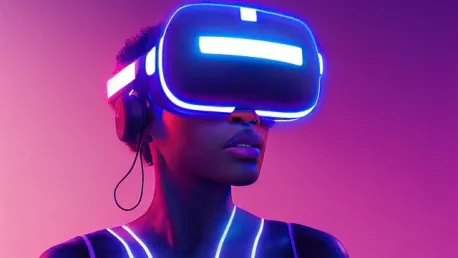The retail industry is undergoing a remarkable transformation with the adoption of cutting-edge technologies like Augmented Reality (AR), Virtual Reality (VR), and Artificial Intelligence (AI). These innovations are not just enhancing customer experiences but also optimizing operations and driving future growth. With the increasing expectations of shoppers, retailers are continually exploring ways to integrate these technologies effectively to stay competitive. By leveraging these technological advancements, retailers are reshaping their models and creating immersive, personalized shopping experiences that were once unimaginable.
In essence, the fusion of AR, VR, and AI is rapidly becoming a game-changer for the retail sector. Businesses that quickly adapt are reaping the rewards of increased customer engagement and operational efficiency. From virtual try-ons to AI-driven inventory management, these technologies offer a myriad of possibilities to refine the customer journey and streamline back-end processes. As the retail landscape evolves, it’s clear that AR/VR and AI are no longer optional; they are integral to staying ahead in a competitive market where customer experience is paramount.
The Rise of Technological Advancements in Retail
Across the retail landscape, the integration of AI, AR, and VR technologies is becoming more prevalent. Retailers are increasingly adopting these technologies to provide personalized and engaging shopping experiences. AI, in particular, is pivotal in optimizing various aspects of retail operations, from customer interactions to supply chain management. The inclusion of these technologies is significantly raising the bar for customer expectations and satisfaction.
AR and VR are enhancing both online and in-store experiences by creating immersive, interactive environments. This trend is crucial for brands aiming to meet modern consumer expectations and improve operational efficiency. Retailers leveraging these technologies are witnessing an increase in customer engagement and loyalty. With AR, customers can visualize furniture in their living spaces or virtually try on clothes, making shopping more intuitive and fun. VR, meanwhile, offers virtual tours and product demonstrations, adding a new dimension to the retail experience.
Companies are also employing AI for predictive analytics and personalized marketing, ensuring that customers receive recommendations tailored to their preferences and behaviors. AI algorithms analyze shopping habits and can suggest products that are more likely to be purchased, thus increasing conversion rates. This level of personalization, powered by AI and AR/VR integration, is transforming the way customers interact with brands, making shopping experiences more seamless and enjoyable.
Impact of AI on Retail Operations
AI is proving to be a transformative force within the retail sector, offering a multitude of applications that drive efficiency and personalization. AI facilitates virtual try-ons and personalized shopping experiences, which are crucial for attracting and retaining customers. Moreover, it plays a pivotal role in supply chain optimization and fraud detection, making retail operations more efficient and secure. Retailers deploying AI-driven solutions find themselves better equipped to handle inventory management, thus ensuring optimal stock levels and minimizing waste.
With image recognition and guided shopping capabilities, AI helps customers locate products and receive tailored recommendations. This not only enhances the shopping experience but also boosts sales and customer satisfaction. Retailers benefit from AI-driven inventory management, ensuring that products are always in stock and available for purchase. This reduces instances of stockouts and overstock, making the supply chain more effective.
The improved supply chain efficiency resulting from AI adoption leads to faster delivery times, meeting the growing demand for quick and reliable service. Additionally, AI helps in detecting and preventing fraud, safeguarding both retailers and customers. The comprehensive capabilities of AI extend to analyzing customer data to provide actionable insights, helping retailers make informed decisions. As AI continues to evolve, its applications in retail will only broaden, further revolutionizing how businesses operate.
Transforming Shopping Experiences with AR and VR
AR and VR technologies are revolutionizing the way customers shop by providing immersive and interactive experiences. Augmented Reality allows shoppers to visualize products in real-time, making decisions easier and more informed. For instance, AR-powered apps enable virtual try-ons, where customers can see how clothes, jewelry, or eyewear look on them without physically trying them on. This capability is particularly attractive in the context of online shopping, where the inability to try on products is a significant drawback.
Virtual Reality, on the other hand, offers entirely immersive experiences by simulating physical stores or providing virtual tours. Shoppers can walk through virtual stores, interact with products, and even receive customer service, all from the comfort of their homes. These technologies not only enhance the digital shopping experience but also create unique brand stories and product demonstrations that captivate consumers. The increasing preference for AR-powered shopping apps reflects a growing desire for such advanced shopping experiences.
The direct impact of AR and VR on customer satisfaction is significant. By offering a tangible view of how products will look and feel, these technologies reduce the uncertainty inherent in online shopping. Customers feel more confident in their purchase decisions, leading to higher conversion rates and fewer returns. Additionally, AR and VR create an engaging shopping experience that attracts younger, tech-savvy consumers, helping retailers tap into new demographics.
Consumer Preferences and Adoption Rates
The prevalence and adoption rates of AR/VR and AI technologies in retail are on the rise. Reports indicate that a significant percentage of shoppers are inclined to shop more frequently using AR-powered applications. These consumers are also willing to pay a premium for enhanced and personalized shopping experiences provided by AR and AI. This trend underscores the growing importance of integrating advanced technologies into retail operations to meet consumer demands and stay competitive.
Luxury fashion shoppers and general consumers alike show a preference for AR-integrated shopping experiences. This trend highlights the significance of interactive and customizable shopping environments in influencing consumer behavior and purchasing decisions. Retailers who invest in these technologies are finding that they can attract a broader customer base and retain existing customers with superior shopping offerings.
Furthermore, the willingness of customers to pay more for enhanced shopping experiences suggests that there is a substantial market for AR and AI-integrated products. Retailers can capitalize on this by offering premium features that justify the higher price points. As consumer expectations continue to evolve, the adoption of AR, VR, and AI will become a standard rather than an exception, setting the stage for a new era of retail.
Overcoming Challenges in Implementation
Despite the evident benefits, implementing AR and AI technologies in retail comes with significant challenges. The high cost of software and the need for advanced technological infrastructure can be prohibitive for some retailers. Additionally, integrating these technologies with existing systems, such as inventory management and point-of-sale systems, poses a considerable hurdle. These complexities necessitate careful planning and substantial investment, making it essential for retailers to weigh the potential returns against the costs.
Another critical concern is network connectivity, especially in areas with inadequate infrastructure. For AR applications to function effectively, robust and reliable network connections are essential. This issue is particularly pressing in tier 2 cities, where connectivity may not be as robust. Addressing these challenges through partnerships and strategic collaborations can help brands overcome these barriers and maximize the benefits of AR and AI technologies.
Brands can partner with CGI and imaging agencies to create high-quality visual content and product visualizations, ensuring that the AR experiences are seamless and engaging. These collaborations can enhance global marketing campaigns, offering localized content that resonates with diverse customer segments. By tackling these challenges head-on, retailers can unlock the full potential of AR, VR, and AI technologies, paving the way for a more innovative and competitive market landscape.
Future Trends and Prospects
The retail industry is undergoing a significant transformation thanks to the integration of advanced technologies like Augmented Reality (AR), Virtual Reality (VR), and Artificial Intelligence (AI). These technologies are not merely elevating customer experiences but are also enhancing operational efficiencies and driving future growth. As shopper expectations continue to rise, retailers are actively seeking innovative methods to incorporate these technologies to maintain competitiveness. By leveraging AR, VR, and AI, retailers are revamping their business models to offer immersive and personalized shopping experiences that were once unfathomable.
In essence, the blend of AR, VR, and AI is rapidly revolutionizing the retail sector. Companies that adapt swiftly are enjoying the benefits of higher customer engagement and improved operational efficiency. From virtual fittings to AI-powered inventory management, these technologies provide numerous opportunities to enhance the customer journey and streamline back-end processes. As the retail landscape changes, it’s evident that AR, VR, and AI are no longer optional; they are essential to staying competitive in a market where customer experience is critical.








